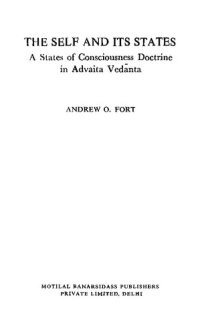
Ebook: The self and its states: A states of consciousness doctrine in Advaita Vedanta
Author: Andrew O. Fort
- Genre: Other Social Sciences // Philosophy
- Year: 1990
- Publisher: Motilal Banarsidass Publishers
- City: Delhi
- Edition: 1
- Language: English
- pdf
The introduction —Chapter I— describes how I became interested in turiya and the catuspad doctrine in Advaita thought, and mentions Western "transpersonal psychology" in a preliminary way. After Mote general comments on early Advaita ontology and epistemology, I more extensively describe turiya and the catuspad doctrine in the Advaita context. I then briefly look at some Indian (and Western) assumptions about consciousness, closing with a definition of the terms consciousness and state of consciousness.
The central portion of the book describes the development of turiya and the catuspad doctrine in Advaita thought. I start with Vedic and early Upanisadic references to this scheme, then focus on the Mandukya Upanisad and the first prakarana of Gaudapada's karikas on the MaU. These well-known texts are central for explicating turiya and the catuspad doctrine. Many see the MaU as outi (scripture) and the karikas as the basic exposition of the MaU's catuspad doctrine.
Sankara, in his commentary on these texts, takes turiya to be synonymous with the self (atman). His commentary is especially interesting as an early (perhaps the first) exposition of his views on non-duality and the self. It also seems to have established the catuspad doctrine as an Advaita scheme for those within and outside the Advaita tradition. In the next chapter, I briefly look at early Advaita views on dreaming, then discuss the special status con lovred on deep sleep in early Advaita thought. Sankara and others take deep sleep to be serene, blissful rest, and the latent, or seed, condition of waking and dream. The relation of Patafijali's Yoga to the states doctrine is briefly mentioned.
The central portion of the book describes the development of turiya and the catuspad doctrine in Advaita thought. I start with Vedic and early Upanisadic references to this scheme, then focus on the Mandukya Upanisad and the first prakarana of Gaudapada's karikas on the MaU. These well-known texts are central for explicating turiya and the catuspad doctrine. Many see the MaU as outi (scripture) and the karikas as the basic exposition of the MaU's catuspad doctrine.
Sankara, in his commentary on these texts, takes turiya to be synonymous with the self (atman). His commentary is especially interesting as an early (perhaps the first) exposition of his views on non-duality and the self. It also seems to have established the catuspad doctrine as an Advaita scheme for those within and outside the Advaita tradition. In the next chapter, I briefly look at early Advaita views on dreaming, then discuss the special status con lovred on deep sleep in early Advaita thought. Sankara and others take deep sleep to be serene, blissful rest, and the latent, or seed, condition of waking and dream. The relation of Patafijali's Yoga to the states doctrine is briefly mentioned.
Download the book The self and its states: A states of consciousness doctrine in Advaita Vedanta for free or read online
Continue reading on any device:

Last viewed books
Related books
{related-news}
Comments (0)